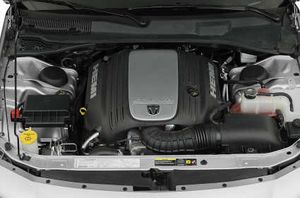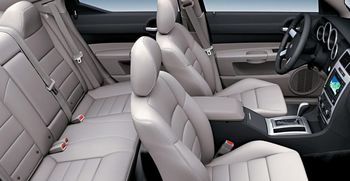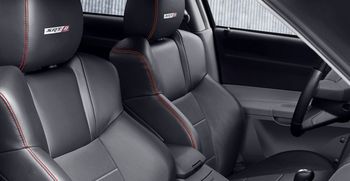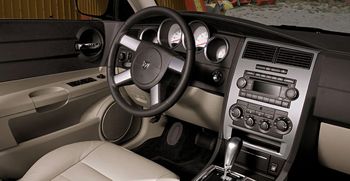.
Dodge Charger Review
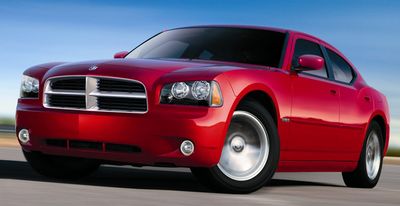
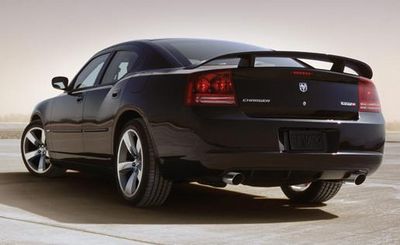
The new Dodge Charger retains its predecessor’s “all business” aggressive looks and muscle power. However, in this new incarnation of an American classic, it incorporates many creature comforts and technological advancements as well. At its core the Charger still offers over 425 horsepower at 6,200 rpm from the top of the line 6.1L SRT HEMI V8 engine and to control this power Dodge provides unobtrusive driving assists that allow skilled drivers freedom and regular drivers excellent safety nets. The Charger truly embodies how far muscle cars of yesterday have improved for today’s uni-dimensional consumers.
See also the main fact sheet for the Dodge Charger.
High Points
- Multi-displacement system is seemless
Low Points
- The break pedel is inelegant, imprecise, and vague (USA Today)
- It is not as inspiring as the Ford Mustang GT or Pontiac GTO (Kelley Blue Book)
- A-pillar blindspots are large (New Car Test Drive)
Performance and Handling
The 3.5-liter V6 produces 250 horsepower and is EPA rated 19/27 mpg City/Highway. When pushed, the V6 breathes a bit harder than the V8 and requires a little more room when passing on crowded two-lanes.
The V8s feature a multi-displacement system that conserves fuel by shutting down four cylinders when they're not needed to maintain the car's momentum, is invisible; we knew it was there and were looking for it, and we never felt the slightest trace. The 5.7-liter Hemi V8 that comes in the R/T is rated at 340 horsepower.
All of the Chargers are good cruisers, comfortable motoring along at 70-80 mph. The Charger is quiet at that speed, with little wind or road noise. Steering in the SE and SXT models seems a bit over-assisted at times, and could use more on-center feel. The re-geared setup that comes with the Road/Track Performance Group delivers better steering feel across the speed range.
Around town, the SRT8 scrapes like a Corvette in deep gutters and other sharp transitions. Extra care has to be taken when parking not to scrape on those concrete stops they put out to keep people from pulling over the sidewalk; this is exacerbated by the significant length of the Charger because you're trying to get the rear of the car out of the traffic. The front spoiler is high enough that it's usually not a problem but beware high curbs. The Charger handles well along the winding, two-lane back roads even when carrying speeds substantially in excess of the posted limits. The Charger is moderately nose-heavy and will plow, or understeer, momentarily before the electronic stability program steps in; this means the program's threshold is set high enough that better drivers can alter their line through a corner with deft throttle application; drive too hard and you'll become aware you're pushing the envelope.
The Performance Group comes with fatter, stickier tires (P235/55R18 Michelin MXM4s) and suspension tweaks that combine to reduce body lean in corners and quicken turn-in response. A price is paid, however, as the sportier suspension and tire combination resonates more over broken pavement, not harshly, but noticeably. The tires that come standard on the R/T and optional on the SXT are neither as wide nor as grippy, but offer a quieter ride.
The AutoStick transmission works equally well in either Automatic or Manual mode. In Automatic mode, full throttle upshifts wait until redline and downshifts for passing are executed with minimal delay. In Manual mode, the transmission holds a gear to red line before shifting up a gear (unless you shift sooner, of course), which then becomes the selected gear. Only by tromping the gas in manual mode can you force a downshift, and then only for as long as the pedal is held to the floor; ease up ever so slightly, and the higher gear takes back over, and somewhat abruptly.
The Charger's brake hardware is shared with Mercedes-Benz, but the software code for the stability program, brake assist and traction control systems is written by and for Dodge. Mercedes engineers could learn something from Dodge. Pedal feel is firm, braking is reassuringly linear and there's no perceived interference from the electronic watchdogs, yielding smooth, controlled stops.
Gas Mileage
As seen on Autos.com, in the mid-size car MPG rankings, the 2007 Dodge Charger is in 18th place with 21/28 MPG.
Safety
The Dodge Charger comes standard with the following features:
- Safety cage
- Multistage driver and front-passenger airbags
- Tire pressure monitor
- Remote Keyless Entry
- Child seat anchors
Reliability and Maintenance
Dodge offers a 3 year/36,000 mile limited warranty which includes towing assistance.
Interior and Comforts
Inside, the Dodge Charger has much in common with the Magnum, which is essentially the wagon version of this car.
The instrument cluster arrangement is pleasantly informative. The big round speedometer and tachometer share the top half of the steering wheel opening, with fuel and coolant temperature gauges down in the left and right corners. Air conditioning registers fill the top of the center stack, above the stereo/navigation display, with the climate control panel properly positioned beneath that, all intuitively arrayed and outfitted and within easy reach of the driver and front seat passenger. Models without the navigation display have a small cubby below the air conditioning controls.
Steering column stalks are imported from the Mercedes-Benz parts bin, including their awkward positioning. The more frequently used, heavily end-weighted turn-signal stalk/washer lever droops down somewhere around the 8 o'clock position, while the cruise control sits up around 10 o'clock. The headlight switch and dash light rheostat are located in the dash next to the driver's door, with the remote trunk release below. Outside mirrors are adjusted with a joystick in the door armrest. The power seat adjustments are located on the outboard side of the seat bottom and operate intuitively. Large, six-way adjustable, rectangular ventilation registers fill in each end of the dash.
The fabric-covered seats that come standard are comfortable, with adequate thigh support and side bolstering. Stepping up to the performance seats in the option packages gets more pronounced bolsters, which is good for those rare times when a twisty two-lane beckons, but not as good for climbing in and out of the car every day. And, of course, the top grade, suede-trimmed and embroidered seats in the Daytona nicely complement the boy-racer graphics of the exterior. Thanks to the sedan-spec wheelbase, there's plenty of rear seat room, too, even with front seats at their rearmost positions. No head restraint for the rear center seat is provided, however, making this car better for four adults than five.
Visibility from the driver's seat is good, but suffers a bit from safety measures and styling dictates. A-pillars designed to meet roll-over standards are thick, which makes checking for pedestrians and crossing traffic becomes more difficult. The view through the inside rearview mirror quickly puts to rest any lingering illusions about the Charger being a coupe; the rear window is a long ways back. And the C-pillars are also fat, and require careful checking during lane changes; they also provide great hiding places for pacing patrol cars. (The A-pillars are the posts between the windshield and front side windows: the C-pillars are the posts between the rear windscreen and rear side windows.)
The entertainment system installation takes a novel, but extremely well-integrated approach. The screen hides beneath a cover on the front center console when not in use, then pivots up between the front seats
Exterior
The Charger recalls the 1966 Dodge Coronet. Despite its fastback, two-door hardtop styling, the old Charger was somewhat blocky, with a squared-off front end, superficially sculpted slab sides and equally vertical backside. There was the barest hint of a so-called Coke bottle look, with the body sides slightly pinched in about where there would have been a B-pillar. Not until the 1968 model year was any attention paid to moving the car rapidly through the air with minimal disturbance. The 2006 Charger starts at much the same place on the automotive styling evolutionary curve.
And for good reason. The same design team that parented the Chrysler 300 and Dodge Magnum birthed this new Charger. The Charger is built on the same platform as those two, but is three inches longer overall. The Charger reportedly was planned all along to be a sedan version of the Magnum.
With this legacy, it's no surprise that there is an uprightness to the Charger's silhouette, regardless of viewing angle. The front end tilts forward as if it's leaning into the wind, specifically to recall the brutish, pre-aero-age styling of its muscle car era namesake. Dominating the front of the car are the trademark Dodge crosshairs, chromed on the SXT and R/T, body-color in the SE and SRT8 and flat black on the Daytona. Compound halogen headlights peer out under hooded, almost scowling brows. A thin, trifurcated air intake slices across the lower portion of the front bumper. Daytona and SRT8 wear a flat-black chin spoiler. Fog lamps on the SXT and higher models fill small, sculpted insets at the lower corners.
From the side, the demi-fastback roofline and glasshouse look more grafted onto the somewhat fulsome body than a natural extension of the overall styling theme, very much as if the designer were trying to make a sedan look like a coupe. The beltline arcs softly back from a slight droop over the headlights to about midway in the rear side window, then kicks up over the rear quarter panel, visually bulking up the car's already hefty haunches.
The rear perspective shows a tall, almost vertical backside, with large taillights draped over the upper corners. A modest, Kamm-like lip stretches across the trailing edge of an expansive trunk lid, atop which sits a lift-suppressing spoiler on the Daytona and SRT8. A recess in the bumper holds the license plate. On the SE and SXT a single exhaust tip exits beneath the right-hand side, while the V8-powered models sport chrome-tipped, muscle car-idiom, dual exhausts.
The Charger's styling is loosely reflected on NASCAR's Nextel Cup cars, primarily seen in the crosshair grille and the painted-on taillights.
Styles and Options
The Dodge Charger is available in 4 trims: SE, SXT, R/T, and SRT8.
SE
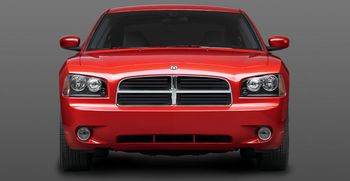
- 250-hp 3.5-liter V6
- Five-speed AutoStick automatic
- Cloth upholstery
- Air conditioning
- Cruise control
- Tilt-and-telescope steering wheel
- Soft-finish urethane-wrapped steering wheel and shift knob
- Floor mats
- Power door locks, outside mirrors, and windows
- Remote trunk release
- Two power points
- Driver and passenger lumbar adjustment
- AM/FM/CD stereo with auxiliary input jack
- Steel wheels with bolt on covers
- All-season P215/65R17 tires
The Protection Group
- Front and rear side-curtain airbags
- Cabin air filtration
- Self-sealing tires
The Smoker's Group
- Cigarette lighter
- Ash tray
The Convenience Group 1
- Eight-way power driver's seat
- Adjustable pedals
SXT
- 250-hp 3.5-liter V6
- Five-speed AutoStick automatic
- Eight-way power driver's seat
- Leather-wrapped steering wheel and shift knob
- 60/40 split folding rear seat with fold-down center armrest
- Boston Acoustics stereo with six speakers and 276-watt amplifier
- Fog lamps
- Trunk cargo net
- Cast aluminum wheels
The Protection Group
- Front and rear side-curtain airbags
- Cabin air filtration
- Self-sealing tires
The Smoker's Group
- Cigarette lighter
- Ash tray
The Comfort Seating Group
- Heated front seats
- Leather-trimmed bucket seats
- Power adjustable pedals
- 8-way power front passenger seat
The Convenience Group III
- Automatic headlights
- Dual-zone climate control
- Auto down/up front windows
- DVD-based navigation system
R/T
- 340-hp 5.7-liter V8
- Five-speed AutoStick automatic
- Folding and heated mirrors
- 160-mph speedometer
- Upgraded brakes
- Polished aluminum 18-inch wheels
- Larger fuel tank
- Dual exhaust
- Tire-pressure monitoring system.
Convenience Group II
- Dual-zone, automatic climate control
- Heated front seats
- Power adjustable pedals
- 8-way power front passenger seat
- One-touch, automatic up and down power windows with anti-pinch auto-reverse
The Electronics Convenience Group
- Security alarm
- Programmable universal garage door opener
- Trip computer
- Selectable vehicle information display
- Compass
- A set of steering wheel-mounted, redundant audio controls
The Road/Track Performance Group
- Unique aluminum wheels with black accents
- Sportier steering
- Self-leveling shocks
- Sport seats
- Performance suspension
- A tweaked V8 making 350 horsepower
- Front and rear spoilers
- 20-inch wheels
The Daytona R/T package
- Mostly the R/T with the Road/Track performance group
- Tuned exhaust
- Assorted aero add-ons
- Flat black graphics front and rear
- A host of interior upgrades that includes a numbered plate on the instrument panel
SRT8
- 425-hp 6.1-liter V8
- Five-speed AutoStick automatic
- Uniquely tuned suspension
- Re-programmed ESC system
- Brembo brakes
- Goodyear Supercar F1 tires
- 20-inch forged aluminum wheels
- 180-mph speedometer
The Super Bee package
- Detonator Yellow with black graphics on the hood, trunk and flanks
- V8/bumblebee hybrid logo
- Dual zone air conditioning
- Heated seats
- Automatic headlights and most of the other comfort and convenience items that are optional on the *Rest of the SRT8 models.
Main Competitors
- Mazda Mazda6: side-by-side comparison
- Volkswagen Passat: side-by-side comparison
- Honda Accord: side-by-side comparison
- Toyota Camry: side-by-side comparison
- Nissan Maxima: side-by-side comparison
- Ford Fusion: side-by-side comparison
- Hyundai Sonata: side-by-side comparison
External Links
WikiCars Contributor Favorites
Dodge Manufacturer Sites
- Dodge Charger - Official US Site
Community Sites
- Dodge Forum & Club - Information & Discussions Regarding Every Dodge Past Or Present
- LX Platform Forums - Dodge Charger, Dodge Magnum, and Chrysler 300 Forums
- Allpar.com - 2006 Charger Page
- chargerforums.com - Dodge Charger Forums
- edmunds.com - Dodge Charger Review
- mph-online.com - Dodge Charger SRT8 Review and Wallpaper
- mph-online.com - Rally Racing with Ralph Giles in the Dodge Charger SRT8
- DetroitWonk - NYPD Buys Dodge Charger Police Cruisers
- jasononcars.com - Review: 2006 Dodge Charger
